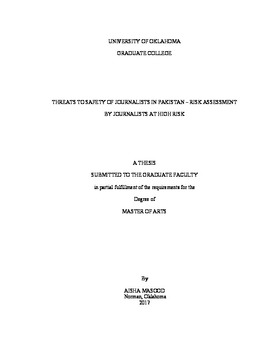| dc.contributor.advisor | Craig, David | |
| dc.contributor.author | Masood, Aisha | |
| dc.date.accessioned | 2017-08-22T19:17:29Z | |
| dc.date.available | 2017-08-22T19:17:29Z | |
| dc.date.issued | 2017 | |
| dc.identifier.uri | https://hdl.handle.net/11244/51917 | |
| dc.description.abstract | Designed in the light of UNESCO’s academic research agenda on the topic of safety of journalists, the study examines opinions and actions of Pakistani journalists at high risk: how they view safety issues, and if they minimize risk at work. It also includes their recommendations on how journalistic practices could be improved to protect their safety better. The study findings suggest that harassment (pressure from state and non-state actors) and psychological threats (mental stress, trauma) are the most common threats faced by the journalists. Balochistan, Khyber Pakhtunkhwa and Federally Administered Tribal Areas were considered more dangerous and riskier than other regions of the country. The study also depicts that even though the journalists said they minimize risk at work, the reported actions suggested they did not take some steps to do so. The journalists recommended training of journalists as well as of media employers, policymaking and implementation of guidelines, risk assessment, counseling, and other recommendations to protect journalists’ safety better. | en_US |
| dc.language | en_US | en_US |
| dc.subject | Mass Communications. | en_US |
| dc.subject | Pakistan, journalist, safety, threat, safety of journalists, risk, risk assessment, safety threats | en_US |
| dc.title | THREATS TO SAFETY OF JOURNALISTS IN PAKISTAN – RISK ASSESSMENT BY JOURNALISTS AT HIGH RISK | en_US |
| dc.contributor.committeeMember | Foote, Joe | |
| dc.contributor.committeeMember | Yoon, Doyle | |
| dc.date.manuscript | 2017-07 | |
| dc.thesis.degree | Master of Arts | en_US |
| ou.group | Gaylord College of Journalism and Mass Communication | en_US |
| shareok.nativefileaccess | restricted | en_US |
